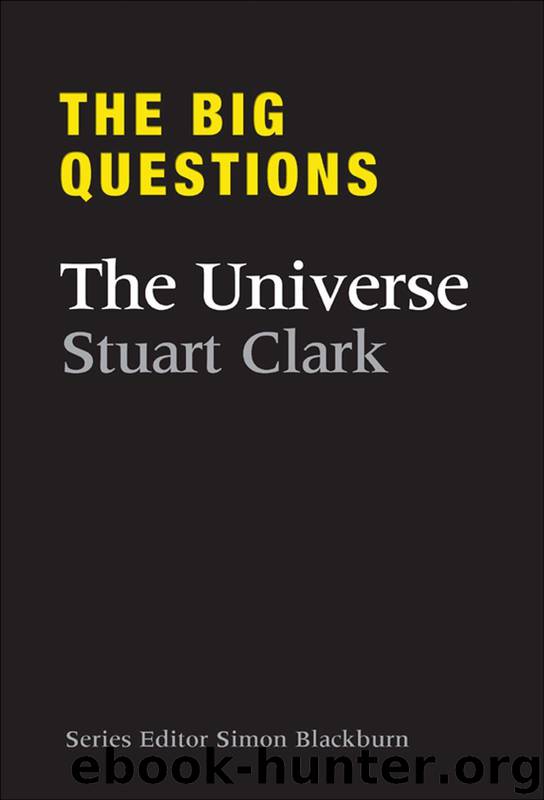The Big Questions The Universe by Stuart Clark

Author:Stuart Clark
Language: eng
Format: mobi
Publisher: Quercus
Published: 2011-10-26T23:00:00+00:00
Hidden assumptions
Many astronomers are coming to rely on the existence of dark matter, but others are growing sceptical. This is because dark matter has an Achilles heel in the form of a hidden assumption: its existence relies on Newton’s law of gravity being accurate and applicable to gravitational fields no matter how weak they might be. Scientists already know that Newton’s law fails in strong gravitational fields, where Einstein’s General Theory of Relativity needs to be applied instead. It is possible that the same is true at the other end of the scale, where gravity is extremely weak.
In 1981, as others were beginning to embrace dark matter, Israeli physicist Mordehai Milgrom proposed a change to Newton’s law of gravity to explain rotating galaxies without the need for new particles. Remembering that gravity produces acceleration in objects (see Was Einstein Right?), Milgrom’s suggestion was that Newtonian gravity changes below a certain acceleration value, so that instead of the force dropping as an inverse square law (double the distance, quarter the acceleration), it begins to drop less sharply, as a simple inverse law (double the distance, halve the acceleration). The critical acceleration at which this happens is minuscule – no more than that produced by the gravitational field of a single sheet of paper – but it has a dramatic effect at the outer edge of galaxies.
Milgrom showed that by making weak gravitational fields pull a little harder than expected, theoretical models could successfully show the stars moving with uniform speed all the way out to the extremities of a galaxy. In the vast majority of cases, this produced better agreement with observations than the dark matter models. He called his idea ‘Modified Newtonian Dynamics’ (MOND) and, although it currently remains a minority view, if the dark matter detection experiments fail to produce any results, and neutralinos are not produced at the Large Hadron Collider, then perhaps more and more astronomers will contemplate what once seemed impossible: that Newton’s theory of gravity needs an update.
The drawback that some see with MOND is that it has no theoretical underpinning. This makes many astronomers reluctant to take it seriously, but there are historical precedents for this kind of ‘discovery first, understanding later’. Kepler’s laws of planetary motion had no theoretical underpinning when he first proposed them early in the 17th century. He simply scrutinised the data and found an equation that reproduced them. Only in 1687 did Newton’s Theory of Universal Gravitation provide an understanding of why Kepler’s laws worked. Throughout the history of astronomy, laws have been deduced from observations before theories could explain them.
Yet MOND is not flawless; the hypothesis struggles to reproduce the motion of clusters of galaxies, requiring more matter than can be seen to make things work. So are we back to needing exotic dark matter? Possibly not, as astronomers think that there may be a substantial amount of normal matter hiding in galaxy clusters, in the form of warm gas. If they can detect this, using telescopes sensitive
Download
This site does not store any files on its server. We only index and link to content provided by other sites. Please contact the content providers to delete copyright contents if any and email us, we'll remove relevant links or contents immediately.
Tools of Titans by Timothy Ferriss(7807)
Turbulence by E. J. Noyes(7697)
Astrophysics for People in a Hurry by Neil DeGrasse Tyson(4999)
Secrets of Antigravity Propulsion: Tesla, UFOs, and Classified Aerospace Technology by Ph.D. Paul A. Laviolette(4984)
Design of Trajectory Optimization Approach for Space Maneuver Vehicle Skip Entry Problems by Runqi Chai & Al Savvaris & Antonios Tsourdos & Senchun Chai(4837)
Room 212 by Kate Stewart(4731)
Pale Blue Dot by Carl Sagan(4613)
The David Icke Guide to the Global Conspiracy (and how to end it) by David Icke(4376)
A Journey Through Divination and Astronomy by Publishing Pottermore(4248)
Apollo 8 by Jeffrey Kluger(3511)
Goodbye Paradise(3442)
Losing the Nobel Prize by Brian Keating(3424)
COSMOS by Carl Sagan(3346)
The Five People You Meet in Heaven by Mitch Albom(3334)
Brief Answers to the Big Questions by Stephen Hawking(3239)
How to Read Water: Clues and Patterns from Puddles to the Sea (Natural Navigation) by Tristan Gooley(3236)
How to Read Nature by Tristan Gooley(3073)
The Order of Time by Carlo Rovelli(3073)
A Brief History of Time by Stephen Hawking(2819)
